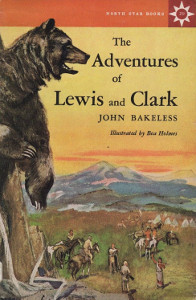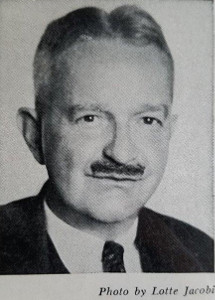The Adventures of Lewis and Clark

Author:
John Bakeless
Illustrator:
Bea Holmes
Publication:
1962 by Houghton Mifflin Company
Genre:
Biography, Geography, History, Non-fiction
Series:
North Star Books ![]() Members Only
Members Only
Series Number: 29
Pages:
183
Current state:
This book has been evaluated and information added. It has been read but content considerations may not be complete.
Book Guide
Search for this book used on:
Tall, blond, blue-eyed Meriwether Lewis and tall, red-haired Billy Clark were as brave, bright and resourceful as any pair of frontiersman President Jefferson could have chosen. They were sent in 1803 to lead an expedition across the mysterious, newly acquired western lands, from the fur-trading village of St. Louis to the mouth of the Columbia River. On part of this perilous journey they had the assistance of the attractive, courageous Shoshone Indian girl, Sacagawea.
It took every bit of stamina and brains these two young army officers possessed to fight their way up the turbulent Missouri, over the unmapped mountains and down the rapid Columbia to the Pacific. But their expedition proved for the first time that thousands of unknown miles of our continent could be explored and traversed.
Every mile of the way presented a new challenge. For instance, within a single day and night Lewis, wandering alone on the prairie, killed a buffalo, then, with unloaded gun, ran for his life and plunged into the Missouri to escape and enraged bear. Soon thereafter he met an unidentified animal "of the tiger kind", probably a mountain lion. On the following morning he awoke to find a huge rattlesnake coiled on the bough above him. Not every twenty-four hours produced so much action. But every day of the journey was exciting.
Lewis wrote careful reports, doctored the injured and ailing, and made scientific observations. William Clark, younger brother of the Revolutionary War hero, General Rogers Clark, drew maps of the entire expedition.
Both leaders kept journals; and both did what they could to protect their "Corps of Discovery" from treacherous Indians, prairie fires, floods, heat and thirst, subzero cold and famine. Their adventures constitute an American Classic. And John Bakeless gives us a vivid, authentic picture of what it was like to explore the West when it was really wild.
From the dust jacket
Thomas Jefferson had an insatiable curiosity. He wanted to know what lay in the remote, unexplored regions west of the Mississippi. Four times he planned expeditions across the North-American continent—and only in his final attempt was he rewarded.
It was much easier the fourth time, principally because Jefferson was now the President of the United States. Shortly he could proclaim that neither the Spanish nor the French controlled the mouth of the Mississippi, or the vast Louisiana Territory, which had just been purchased from Napoleon for fifteen million dollars—the best real estate bargain our nation ever made.
Two young men, originally from his own state of Virginia, were to lead this expedition, which began in 1803 and ended successfully in 1806. They had orders to explain to the Indians that their new "White Father" lived in Washington (not in Paris or Madrid); that peace among all the Indian tribes was greatly desired, and that no harm would come to Indian nations co-operating as allies of the United States. The Indians were somewhat confused and bewildered by these incomprehensible international developments, but they became much more amiable when they were given "Indian Commissions," medals and other gifts.
In addition to their role as frontier diplomats, these two young men were to report at length on the Missouri River country, the completely unknown mountain regions, and the westward-flowing Columbia. They were also asked to keep journals, assemble Indian vocabularies from a dozen or more tribes, make botanical and zoological collections, report on the flora and fauna, and demonstrate to the world that this wilderness could be traversed.
As proved by their fascinating but ungrammatical journals, neither Lewis nor Clark was an accomplished writer. But they carried out their difficult orders so faithfully that they shed light on our whole trans-Mississippi domain, and greatly contributed to the settling of an area far larger than the original thirteen colonies.
John Bakeless, who is an ardent and dependable researcher, covered every inch of this route on a Guggenheim Fellowship. He also read that journals of Lewis, Clark, and other members of the party, besides unearthing dozens of previously unknown documents on the expedition—from a storeroom in Oregon, an attic in Virginia, a cabin in Idaho, and from various archives and libraries throughout the country. He gives a lively, accurate account of the whole significant adventure.
Sterling North
From the book
General Editor
To view an example page please sign in.
Content Guide
Please sign in to access all of the topics associated with this book and view other books with the same topics.
Please sign in to access the locations this book takes place in and view other books in the same location.
Please sign in to access the time periods this book takes place in and view other books in the same time period.
Please sign in to access information about the content of this book that you may want to consider before reading.
Find This Book
Search for this book used on:




